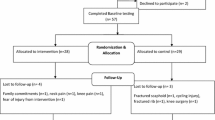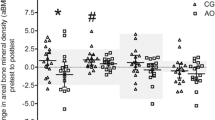Abstract
The aim of this study was to examine and compare the effects of different resistance training protocols on bone marker concentrations in older men. Thirty-seven healthy older male subjects were assigned to one of three groups: high-intensity resistance training (HI-RT, age = 57.5 ± 0.8); low-intensity resistance training with vascular restriction (LI-VRT, age = 59.9 ± 1.0); and control (CON, age = 57.0 ± 1.1). Blood samples were collected before and after 6 weeks of resistance training to measure the changes in bone formation [bone alkaline phosphatase, (Bone ALP)] and resorption (C-terminal cross-linking telopeptide of Type-I collagen, CTX) marker concentrations. A significant main effect for time was detected in Bone ALP to CTX ratio for the exercise groups (p < 0.05). There was a significant group effect for percentage changes in serum Bone ALP (21% for LI-VRT, 23% for HI-RT, and 4.7% for CON) and post hoc analysis identified significant increases in serum Bone ALP concentrations in LI-VRT (p = 0.03) and HI-RT (p = 0.02) when compared with CON. The exercise groups had significantly (p < 0.01) greater strength increases in all upper body and leg exercises compared with CON with no significant differences between the exercise groups except for leg extension strength (HI-RT > LI-VRT, p < 0.05). Serum concentrations of Bone ALP and Bone ALP to CTX ratio improved in both resistance training protocols, suggesting increased bone turnover with a balance favoring bone formation. Therefore, despite using low mechanical load, LI-VRT is a potentially effective training alternative to traditional HI-RT for enhancing bone health in older men.



Similar content being viewed by others
References
Abe T, Yasuda T, Midorikawa T, Sato Y, Kearns CF, Inoue K, Koizumi K, Ishii N (2005) Skeletal muscle size and circulating IGF-1 are increased after two weeks of twice daily “KAATSU” resistance training. Int J KAATSU Train Res 1:6–12
Abe T, Kearns CF, Sato Y (2006) Muscle size and strength are increased following walk training with restricted venous blood flow from the leg muscle, Kaatsu-walk training. J Appl Physiol 100:1460–1466
Baumgartner RN, Koehler KM, Gallagher D, Romero L, Heymsfield SB, Ross RR, Garry PJ, Lindeman RD (1998) Epidemiology of sarcopenia among the elderly in New Mexico. Am J Epidemiol 147:755–763
Beekley MD, Sato Y, Abe T (2005) KAATSU-walk training increases serum bone-specific alkaline phosphatase in young men. Int J KAATSU Train Res 1:77–81
Bemben DA, Buchanan TD, Bemben MG, Knehans AW (2004) Influence of type of mechanical loading, menstrual status, and training season on bone density in young women athletes. J Strength Cond Res 18:220–226
Bemben DA, Palmer IJ, Abe T, Sato Y, Bemben MG (2007) Effects of a single bout of low intensity KAATSU resistance training on markers of bone turnover in young men. Int J Kaatsu Train Res 3:21–26
Bross R, Storer T, Bhasin S (1999) Aging and muscle loss. Trends Endocrinol Metab 10:194–198
Candow DG (2008) The impact of nutritional and exercise strategies for aging bone and muscle. Appl Physiol Nutr Metab 33:181–183
Caulkins C, Ebramzadeh E, Winet H (2009) Skeletal muscle contractions uncoupled from gravitational loading directly increase cortical bone blood flow rates in vivo. J Orthop Res 27:651–656
Clarke B (2008) Normal bone anatomy and physiology. Clin J Am Soc Nephrol 3(Suppl 3):S131–S139
Cosman F, Nieves J, Wilkinson C, Schnering D, Shen V, Lindsay R (1996) Bone density change and biochemical indices of skeletal turnover. Calcif Tissue Int 58:236–243
Delmas PD, Hardy P, Garnero P, Dain M (2000) Monitoring individual response to hormone replacement therapy with bone markers. Bone 26:553–560
Frost HM (2001) From Wolff’s law to the Utah paradigm: insights about bone physiology and its clinical applications. Anat Rec 262:398–419
Fujimura R, Ashizawa N, Watanabe M, Mukai N, Amagai H, Fukubayashi T, Hayashi K, Tokuyama K, Suzuki M (1997) Effect of resistance exercise training on bone formation and resorption in young male subjects assessed by biomarkers of bone metabolism. J Bone Miner Res 12:656–662
Goto K, Nagasawa M, Yanagisawa O, Kizuka T, Ishii N, Takamatsu K (2004) Muscular adaptations to combinations of high- and low-intensity resistance exercises. J Strength Cond Res 18:730–737
Häkkinen K, Kraemer WJ, Newton RU, Alen M (2001) Changes in electromyographic activity, muscle fibre and force production characteristics during heavy resistance/power strength training in middle-aged and older men and women. Acta Physiol Scand 171:51–62
Harris ST, Gertz BJ, Genant HK, Eyre DR, Survill TT, Ventura JN, DeBrock J, Ricerca E, Chesnut CH 3rd (1993) The effect of short term treatment with alendronate on vertebral density and biochemical markers of bone remodeling in early postmenopausal women. J Clin Endocrinol Metab 76:1399–1406
Heaney RP (1994) The bone-remodeling transient: implications for the interpretation of clinical studies of bone mass change. J Bone Miner Res 9:1515–1523
Honig S (2010) Osteoporosis—new treatments and updates. Bull NYU Hosp Jt Dis 68:166–170
Karabulut M, Abe T, Sato Y, Bemben MG (2009) The effects of low-intensity resistance training with vascular restriction on leg muscle strength in older men. Eur J Appl Physiol 108:147–155
Kohrt WM, Bloomfield SA, Little KD, Nelson ME, Yingling VR (2004) American College of Sports Medicine Position Stand: physical activity and bone health. Med Sci Sports Exerc 36:1985–1996
Kraemer WJ, Ratamess NA (2005) Hormonal responses and adaptations to resistance exercise and training. Sports Med 35:339–361
Lester ME, Urso ML, Evans RK, Pierce JR, Spiering BA, Maresh CM, Hatfield DL, Kraemer WJ, Nindl BC (2009) Influence of exercise mode and osteogenic index on bone biomarker responses during short-term physical training. Bone 45:768–776
Lexell J, Taylor CC, Sjostrom M (1988) What is the cause of the ageing atrophy? Total number, size and proportion of different fiber types studied in whole vastus lateralis muscle from 15- to 83-year-old men. J Neurol Sci 84:275–294
Martin B (1993) Aging and strength of bone as a structural material. Calcif Tissue Int 53(Suppl 1):S34–S39 discussion S39–S40
McCall GE, Byrnes WC, Fleck SJ, Dickinson A, Kraemer WJ (1999) Acute and chronic hormonal responses to resistance training designed to promote muscle hypertrophy. Can J Appl Physiol 24:96–107
McCarthy I (2006) The physiology of bone blood flow: a review. J Bone Joint Surg Am 88(3):4–9
Menkes A, Mazel S, Redmond RA, Koffler K, Libanati CR, Gundberg CM, Zizic TM, Hagberg JM, Pratley RE, Hurley BF (1993) Strength training increases regional bone mineral density and bone remodeling in middle-aged and older men. J Appl Physiol 74:2478–2484
Parfitt AM (2000) The mechanism of coupling: a role for the vasculature. Bone 26:319–323
Russo CR, Lauretani F, Bandinelli S, Bartali B, Di Iorio A, Volpato S, Guralnik JM, Harris T, Ferrucci L (2003) Aging bone in men and women: beyond changes in bone mineral density. Osteoporos Int 14:531–538
Ryan AS, Treuth MS, Rubin MA, Miller JP, Nicklas BJ, Landis DM, Pratley RE, Libanati CR, Gundberg CM, Hurley BF (1994) Effects of strength training on bone mineral density: hormonal and bone turnover relationships. J Appl Physiol 77:1678–1684
Shinohara M, Kouzaki M, Yoshihisa T, Fukunaga T (1998) Efficacy of tourniquet ischemia for strength training with low resistance. Eur J Appl Physiol Occup Physiol 77:189–191
Takarada Y, Ishii N (2002) Effects of low-intensity resistance exercise with short interset rest period on muscular function in middle-aged women. J Strength Cond Res 16:123–128
Takarada Y, Takazawa H, Ishii N (2000a) Applications of vascular occlusion diminish disuse atrophy of knee extensor muscles. Med Sci Sports Exerc 32:2035–2039
Takarada Y, Takazawa H, Sato Y, Takebayashi S, Tanaka Y, Ishii N (2000b) Effects of resistance exercise combined with moderate vascular occlusion on muscular function in humans. J Appl Physiol 88:2097–2106
Takarada Y, Sato Y, Ishii N (2002) Effects of resistance exercise combined with vascular occlusion on muscle function in athletes. Eur J Appl Physiol 86:308–314
Turner CH, Robling AG (2003) Designing exercise regimens to increase bone strength. Exerc Sport Sci Rev 31:45–50
Vainionpaa A, Korpelainen R, Leppaluoto J, Jamsa T (2005) Effects of high-impact exercise on bone mineral density: a randomized controlled trial in premenopausal women. Osteoporos Int 16:191–197
Vincent KR, Braith RW (2002) Resistance exercise and bone turnover in elderly men and women. Med Sci Sports Exerc 34:17–23
Conflict of interest
The authors declare that they have no conflict of interest.
Author information
Authors and Affiliations
Corresponding author
Additional information
Communicated by Klaas R Westerterp.
Rights and permissions
About this article
Cite this article
Karabulut, M., Bemben, D.A., Sherk, V.D. et al. Effects of high-intensity resistance training and low-intensity resistance training with vascular restriction on bone markers in older men. Eur J Appl Physiol 111, 1659–1667 (2011). https://doi.org/10.1007/s00421-010-1796-9
Received:
Accepted:
Published:
Issue Date:
DOI: https://doi.org/10.1007/s00421-010-1796-9




